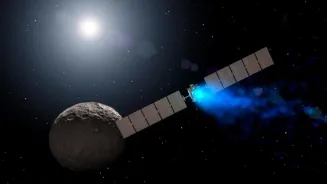NASA has made a startling discovery. The dwarf planet Ceres, nestled between Mars and Jupiter, may have once supported life. Scientists say Ceres harboured three key ingredients essential for life, starting
with water.
NASA’s Dawn mission first spotted bright patches on the planet’s surface, later identified as salt deposits formed from salty water seeping up from beneath. Further studies have confirmed the presence of a vast underground reservoir of salty water, hinting at the planet’s potential to sustain life in the past.
The second critical element discovered was carbon. In 2020, scientists found carbon molecules on Ceres, which are fundamental building blocks of life. Where water and carbon coexist, the possibility of life cannot be ruled out.
The third and most recent discovery relates to energy. A new study revealed that Ceres once had permanent chemical energy. Approximately 2.5 billion years ago, hot water and gases continuously rose from its core, generated by the breakdown of radioactive elements within the planet.
Evidence Suggests Presence of Food For Tiny Creatures
This provided sustenance for small organisms, akin to hydrothermal vents in Earth’s oceans, which are rich energy sources for microbes. Scientists believe a similar environment existed on Ceres, providing ‘food’ for microbes.
However, today’s Ceres is cold and icy. The water inside it has mostly frozen, leaving only thick salty water, and the radioactive processes have weakened. Thus, the current possibility of life on Ceres is virtually nonexistent. Scientists suggest Ceres was most favourable for life when its core was the hottest, a few hundred million years after its formation, with liquid water and a continuous supply of energy below the surface.
Why Does This Discovery Surprise Us?
It reveals that the potential for life is not limited to large planets or moons; even small dwarf planets may have once supported life. This finding adds a new dimension to scientific exploration.
NASA states that while Ceres is presently barren, knowing there was once a possibility of life there is significant. This discovery hints that other small bodies in our solar system might also hold stories of life. Future missions to Ceres may uncover new secrets, leading us to consider that Earth might not have been the sole cradle of life.











